23 серпня 2019 року на моїй тодішній роботі було оголошено на 1 годину коротше. Це для було дуже спрятливо, оскільки через кілька годин того вечора починалася мо подорож! Отже, допрацювавши робочий день до кінця, я приїхав до дому, повечеряв, зібрав рюкзак, передівся у дорожнє і… поїхав в аеропорт! Оскільки рейс Wizzair Київ – Берлін відправлявся о 06:10, а нічний тролейбус 92Н в зв’язку з закриттям Шулявського мосту ходив взагалі невідомо як і за яким розкладом, було вирішено добираться 23.08 останніми рейсами міських тролейбусів. Розрахунок, в принципі, виявився вірним, але тролейбус №9 завершив свою роботу раніше визначеного часу, тобто від Солом’янської площі до аеропорту «Жуляни» довелося здійснити пішу прогулянку…
Отже, до аеропорту я дістався за п’ять хвилин до опівночі. Здивувало досить велика кількість людей в терміналі, хоча найближчий рейс (Київ – Барселона, Vueling) летів тільки о 03:55. Здивувало також відсутність контролю на безпеку при вході в термінали «Жулян» (на відміну від «Борисполі») і наявність певної кількості осіб, сумнівна зовнішність яких мало нагадувала подорожуючих. Але вони розташувались на (дуже не зручних) кріслах з низькими спинками поруч із звичайними пасажирами. Реєстрація на мій рейс розпочалася близько 03:30. Враховуючи, що через 5 і 10 хвилин після мого відправлялося ще 2 рейси Wizzair, в терміналі було вельми людно.
Посадка вчасно, літак стандартний, але з новим трендом – Wizz в сезоні 2019 перейшов на компонування салону кріслами, що не відкидаються. Я чотири рази в 2019 році літав рейсами цієї авіакомпанії і всі разу крісла були саме такої конструкцію. Дуже незручно. Сіли за розкладом о 07:20, кордон пройшли досить швидко, хоча всіх пасажирів примушували пред’явити зворотній квиток або документи з готелю (електронні посадкові та бронювання підходили). Одразу після виходу у зал прибуття натикаюсь на стійку оренди автомобілів, де можна було безплатно взяти карту міського транспорту. А також (за 1 євро) дуже докладну карту міста, на якій в тому числі були відмічені станці метро та міської електрички (щоправда, й навіть така карта одного разу не допомогла мені не заблукати, але про те пізніше). В Києві у книжкових магазинах карти Берліна не продавалися як в принципі, а інтернет-майданчики пропонували карту столиці Німеччину за цілком неадекватними цінами – від 120 грн!
Від терміналу по критій галереї (не помітити неможливо) доходжу до платформи міської електрички (S-bahn). Оскільки весь день планую гуляти Берліном (все одно поселення в готелі не раніше 15-ї години), вирішую купити безлімітний проїздний (зони А та В) вартістю 7,20 Є. Продаються як в автоматі, так і в касі під платформами. На міський електричці (симпатичні червоно-жовті вагони, за формою дуже схожі на наші вагони метро, що невипадково – після 1945 року майже всі вцілілі вагони берлінського метро були вивезені в СРСР, де на їхній основі було створено кілька поколінь рухомого складу метрополітену, що працював на лініях різних міст), незважаючи на ранній час вихідного дня, пасажирів було чимало.
Спочатку електричка їхала повз приватну малоповерхову забудову приміської зони, яку поступово заміщували багатоповерхівки спальних районів, побудованих в останні роки існування НДР (поїзд в’їзжав у місто зі східного боку). Я вийшов на зупинці Warschauer Strasse у колись промисловому, а нині андеграундно-туристичному районі East-End неподалік від річки Шпреє. Одразу навпроти станції електрички знаходиться колишня старовинна будівля відомого хімічного концерну BASF (виробництво фотоплівки, відео- та аудіокасет, дискет тощо). Зрозуміло, чому закрилися – виробництво засобів реєстрації та зберігання інформації за останні 10-15 років вийшло на якісно новий рівень. Але на першому поверсі будівлі (як традиційно в Німеччині для колишніх індустріальних споруд) знаходиться мережевий супермаркет LiDL :-). Тут же знаходиться і кінцева станція лінії метро U1 (Warschauer Strasse), що за кілька сотень метрів виїзжає на красивий старовинний міст, який на мій погляд, є однією з найкрасивіших споруд Берліна, побудованих до XX сторіччя. Має назву Обермаубрюкке, побудований у 1896 році, частково зруйнований у 1945, і потім знову відновлений. Міст має 2 яруси, по нижньому їздить автотранспорт, по верхньому – метро. Висота опор мосту дозволяє проходженню під ним річкових суден (як прогулянкових теплоходів, так і вантажних барж).

Приблизно за 1,5 км від мосту на південь знаходиться на противагу історичності пам’ятка архітектури ХХІ ст. – алюмінієва інсталяція «Молекулярні люди» американського скульптора Джонатана Боровскі, яка являє собою силуети трьох людей, розташованих один відносно іншого під кутом 60 градусів і пронизані круглими отворами, що має означати, що тіла людей складаються з молекул. Скульптури встановлені безпосередньо посеред ріки на сваях, іхня висота по 30 м, а сумарна вага 45 тон.
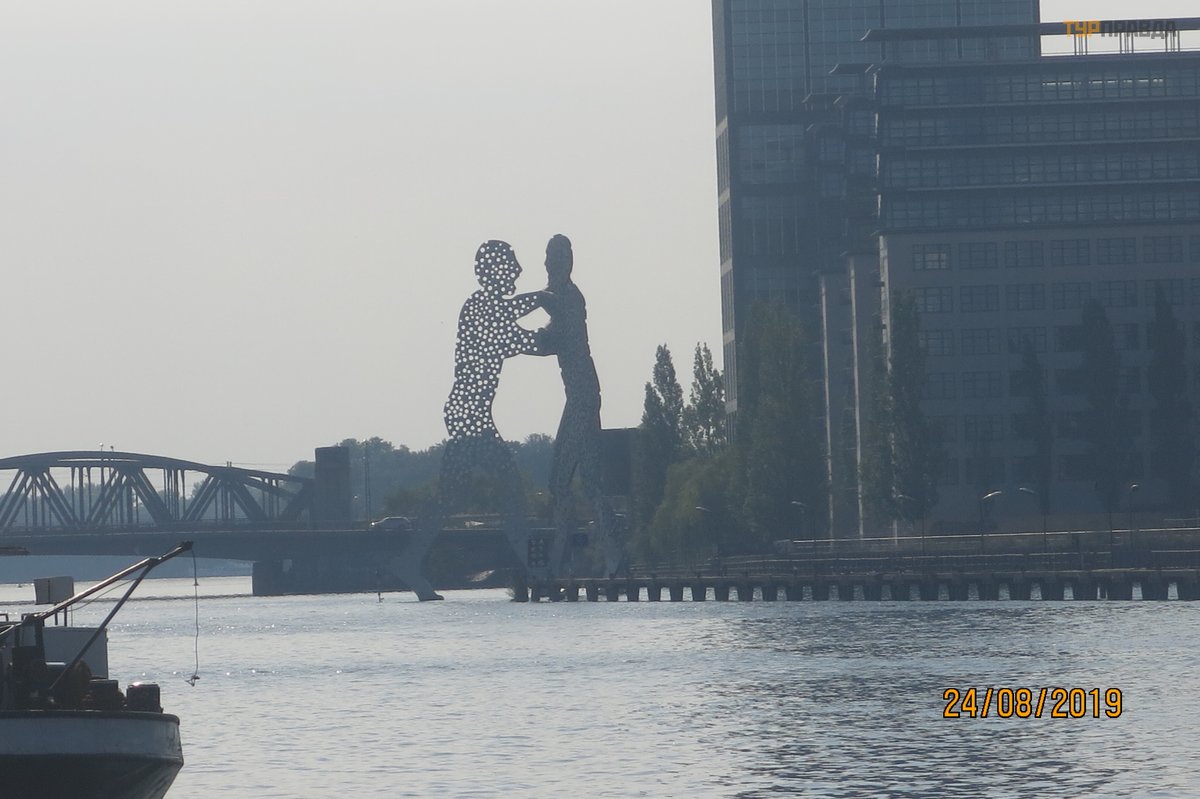
Одразу за мостом, через колишню промзону на північ вздовж вулиці Mulhemstrasse, проходить інший знаковий об’єкт Берліна, можна навіть сказати його символ останніх 58 років – «Berliner Mauer» (Берлінський мур) – багатокілометрова стіна, що протягом 38 років розділяла місто між двома державами. У Іст-Енді знаходиться його найбільш вціліла частина, яку перетворили на величезний музей граффіті і зробили принадою для туристів.
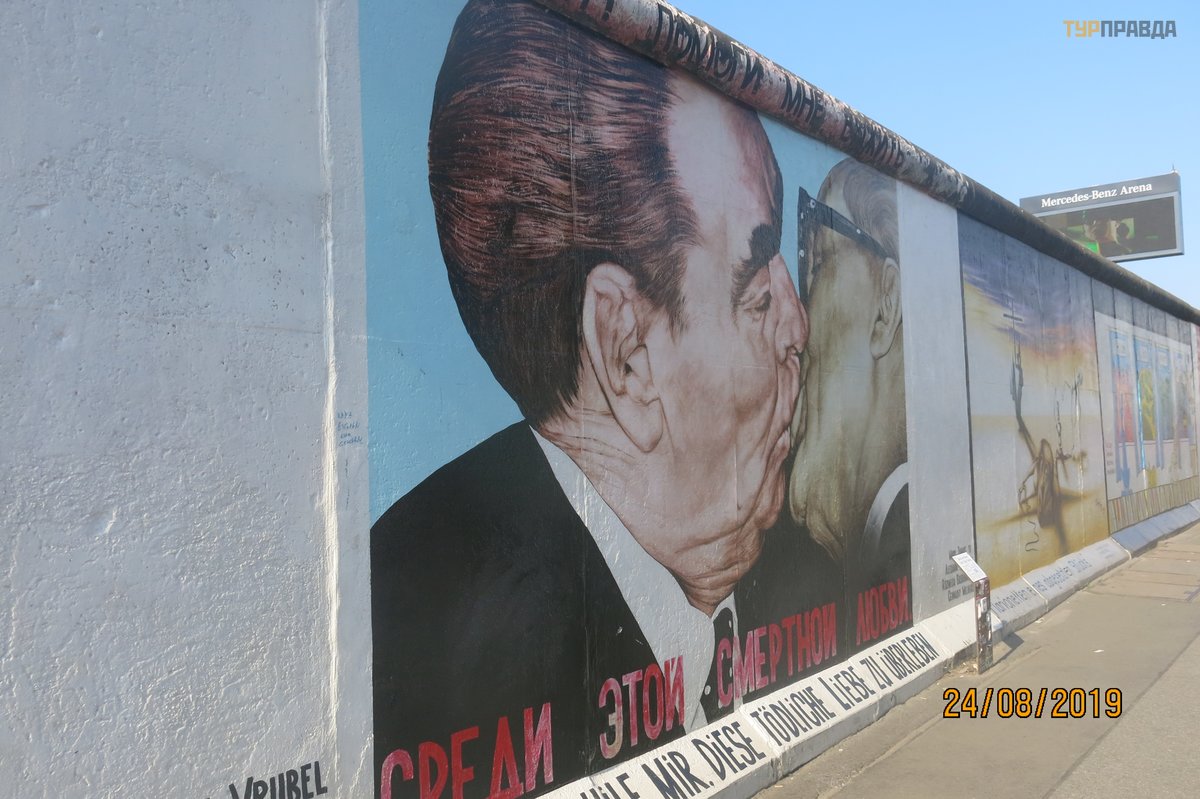
Туристів досить багато, в основному з центральної та південно-східної Азії, європейцям вочевидь ці моменти історії 20 ст. вже нецікаві. Час від часу вздовж стіни (а довжина даного фрагменту близько 1,8 км ) зустрічаються сувенірно-антикварні кіоски та розкладки, де поруч із стандартною туристичною мішурою (магніти, чашки, ручки, кепки, листівки) можуть промайнути старовинний та новий символи Берліна – плюшевий ведмедик та червоний і зелений чоловічки в капелюхах (саме в Берліні на дорожніх світлофорах вперше з’явились силуети людей, що стали символами дозволу та заборони руху), а також цілий пласт антикваріату з комуністичного минулого міста – військовий одяг та головні убори другої половини 20 ст. та різна мілітарна атрибутика. Навіть не знаю, кому зараз це може бути цікаво…
Напротивагу старовині, на іншому боці Mulhemstrasse, побудовно багато сучасної комерційної нежитлової нерухомості (офіси, виставкові майданчики), серед яких домінантну роль займає «Mercedes Benz Arena» (їхній аналог наших Палаців Спорту). Так, поступово дохожу до залізничної станції Ostbahnhof, на якій зупиняються не лише міські електрички S-bahn, а й поїзди міжміських напрямків, в т. ч. і Київ – Берлін (до 2013 року). Під станцією, зрозуміло, знаходиться торгівельний центр. Під’їзжаю на електричці 1 зупинку до Alexander-Platz. Звідси вже починається центр міста. На площі посеред міста розміщено ще один символ Берліна – Берлінська телевежа. На площі досить людно, крім метро та електрички, перетинаються декілька трамвайних маршрутів. На Александр-Платц знаходиться годинник «Urania» – на ньому відображається час у різних годинникових поясах.

Наступна ціль моєї прогулянки – Музейний Острів. По пішохідній вулиці Ратаусштрассе, яка частково перекрита парканами через ремонт, дохожу до «Червоної Ратуші» – діючої Мерії Берліна. Побудована з червоної цегли у 1859-1861 рр. Стиль – неореессанс, триярусна башта має висоту 75 метрів. Біля кожного з кутів нижнього ярусу башти знаходяться по дві скульптури символів міста – бурих ведмедів. На щоглі башти розвивається прапор Берліна – на білому фоні з двома зеленими смугами зверху і знизу також знаходиться, зрозуміло, бурий ведмідь. Ще один цікавий факт про Ратушу: у 1960-1980 рр. західні берлінці називали Ратушу червоною не стільки через її власний колір, а й через колір тих, хто в ній працював – в Ратуші засідала мерія комуністичного Берліна :-)

Зрозуміло, що вздовж пішохідної вулиці знаходиться чимало кафе та магазинів. Серед них побачив і добре підзабуту «Norma» (Німеччину відвідую досить часто, але магазини цієї мережі є далеко не в кожному, навіть великому місті). Візитна картка мережі – суміші фруктово-ягідних джемів – досі входять до асортименту, ціни – на рівні 2015 року – 0,99 євро за 0,25 кг. Шкода, що я в цій поїздці був тільки з ручною поклажею. Пройшовши через невеличкий парк, що виходить на Marx-Engels-Platz з пам’ятником відповідним історичним діячам, я виходжу на широку вулицю Karl-Libknecht-Strasse. Cаме в цей час там проходить невеличкий парад раритетних, мініатюрних і дуже атмосферних автомобілів марки «Trabant», які у 1960-1980 рр. були одним з символів НДР. Вулиця Карла Лібкнехта переходить у однойменний міст, який веде на Музейний Острів. Але ще на мосту, дивлячись праворуч, мою увагу привернула дуже дивна споруда (див. фото нижче).
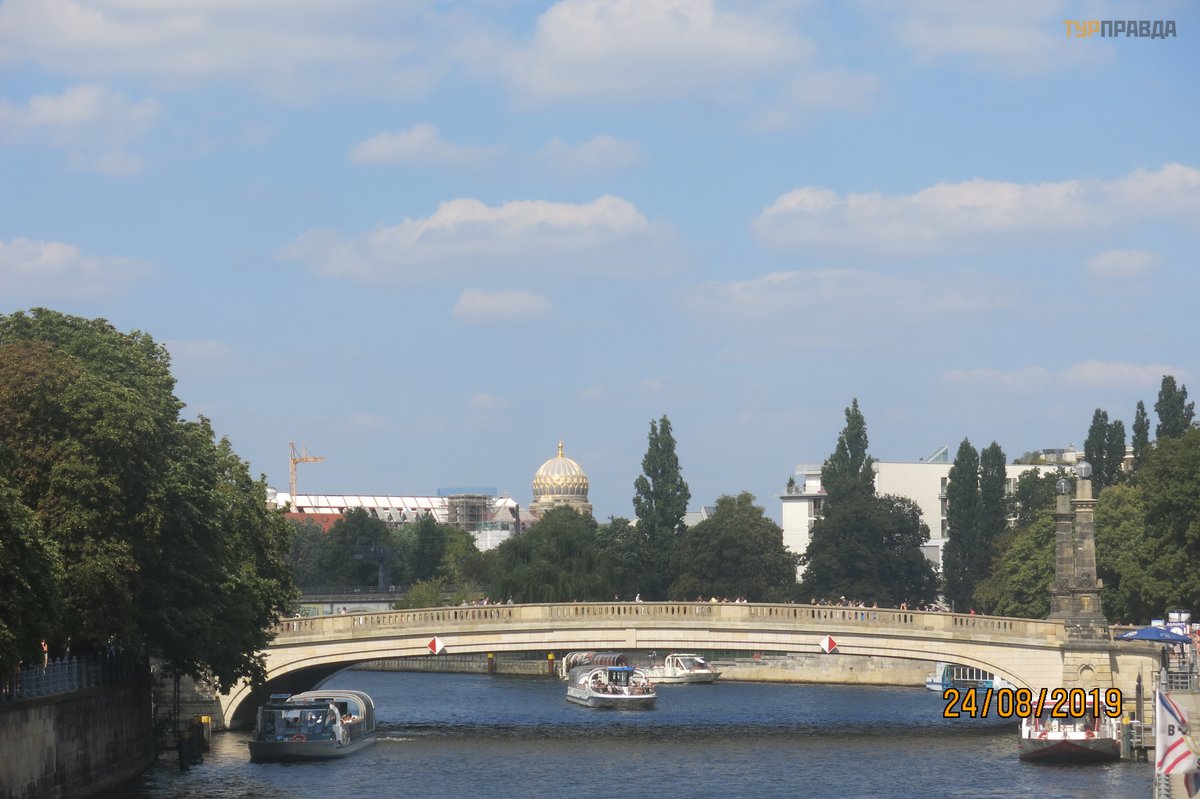
Хто може впізнати цю будівлю з яскравим куполом? Особисто мені вона нагадала мечеть. Домінантною спорудою Острова є Берлінський Кафедральний Собор (в Німеччині всі Кафедральні Собори в будь-кому місті називаютьс Dom). Храм вражає своєю монументальністю і величчю, хоча частина його головного фасаду знаходиться у риштуванні. На острові надзвичайно людно, багато туристичних автобусів, в т. ч. з українськими номерами. На Музейному Острові знаходяться чотири діючі музеї, а саме: Берлінський Музей, Стара Національна Галерея, Пергамський Музей та Музей Боде. Перед Берлінським Музеєм знаходиться велика галявина та красивий фонтан.


Музеї не входили в мої плани, до того ж на вхід були значні черги. Виходжу з Острова також по вул. К. Лібкнехта через Палацевий міст, який після Дворцової площі переходить в бульвар Унтер-дер-Лінден. А на Палацевій площі знаходиться великий «антикварний ринок», що насправді являє «барахолку» речей комуністичної епохи. На південь від Палацової площі проглядається Храм з дуже незвичним зеленим куполом – це була Церква Святої Ядвіги. Отже, йду бульваром «Під Липами» (саме так перекладається його назва), вулиця широка і надзвичайно пряма, настільки, що розташовані в перспективі Бранденбурзькі ворота (довжина бульвару 1,5 км) видно дуже чітко. Метро під бульваром не ходить, саме ведуться роботи по його будівництву, але через певні особливості грунтів під бульваром (за неофіційною інформацією, саме під Унтер-дер-Лінден знаходилася система система секретних тунелів часів Другої світової війни) прокладання метро викликає складнощі.
Приблизно на середині шляху знаходиться площа Бебеля (Bebel Platz), по обидва боки якої розміщені будівлі Університету імені Гумбольдта. Наступний поворот після Бебель-платц – вулиця Фрідіріхштрассе, яка веде до Жандармської площі, площі на якій знаходяться 2 дуже схожі, майже ідентичні собори – Німецький та Французький. А між ними знаходиться будівля Концертного залу (колишнього Драматичного театру). Перед будівлею встановлено пам’ятник видатному німецькому драматургу Ф. Шіллеру.

Жандарменмаркт є значним туристичним місцем – по периметру площі та прилеглих вуличках розташовано багато ресторанів, дорогих готелів, сувенірних магазинів. Тут же туристіам пропонують покататись дивними видами транспорту: фіакрами, запряженими кіньми-ваговозами, старовинним автомобілем із спицевими колесами (такий автомобіль також називали «мотоколяска» одразу після винаходу).
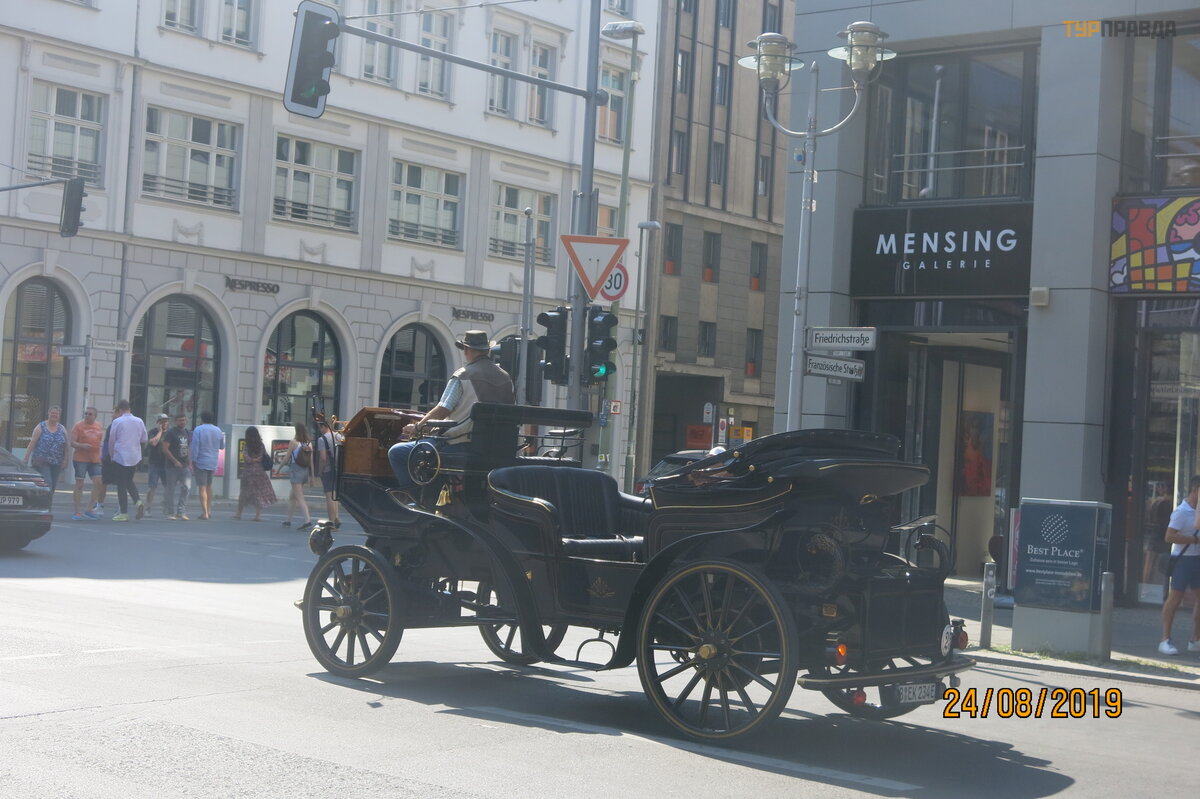
Повертаюсь на Унтер-ден-Лінден. Мою увагу на відрізку, що лишився до Бранденбургських воріт, привернули ще 2 заклади – магазин Ampelmännchen (згаданих мною раніше світлофорних чоловічків) та кафе «Digilateria». Кафе декоровано у стилістиці компанії Microsoft, а на кожному столику встановлені планшети. Ось безпосередньо і Бранденбурзькі ворота. Останні квартали з обох боків – майже виключно посольства різних країн та дорогі готелі. Безпосередньо біля Воріт готується розпочатися великий мотопробіг байкарів. Здивувало, що всі байкери зрілого віку (45-55 років, і навіть старші), молоді абсолютно немає.
За Воротами повертаю до Рейхстагу. Звісно, подавав заявку на відповідному сайті на екскурсію по будівлі чи хоча б на підйом на купол, але мені було відмовлено :-(. Що ж, обмежимося зовнішніми краєвидами. Перед будівлею Рейстагу (а в ньому, як відомо, працює німецький парламент – Бундестаг) традиційна зелена галявина і комплекс фонтанів (що особливо приємно у 35-градусну спеку, яка панувала в ті дні).
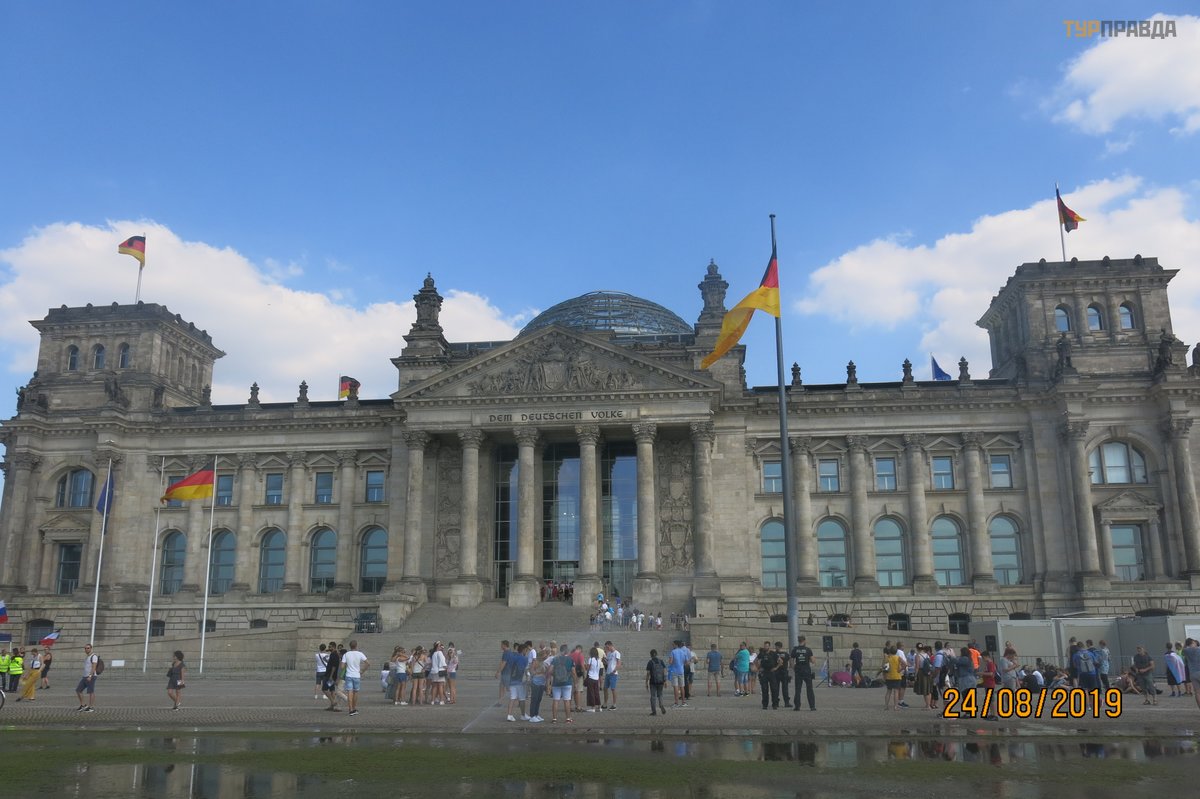
Далі, повз одноіменну станцію метро і комплекс адміністративних будівель, одну з яких повністю займає офіс Канцлера (прем’єр-міністра) Німеччини Ангели Меркель...

...прямую до берега р. Шпреє. На набережній штучно створена зона відпочинку, кілька сотень розкладних крісел, багато кав’ярень, грає музика – одним словом, місцеві відпочивають. Рікою в обидва боки кожні 5-10 хвилин пропливають чималі теплоходи з відкритими верхніми палубами, вщент заповнені пасажирами. З набережної відкривається чудовий вигляд на ультрасучасний центральний залізничний вокзал Берліна та декілька сучасних виставкових центрів.
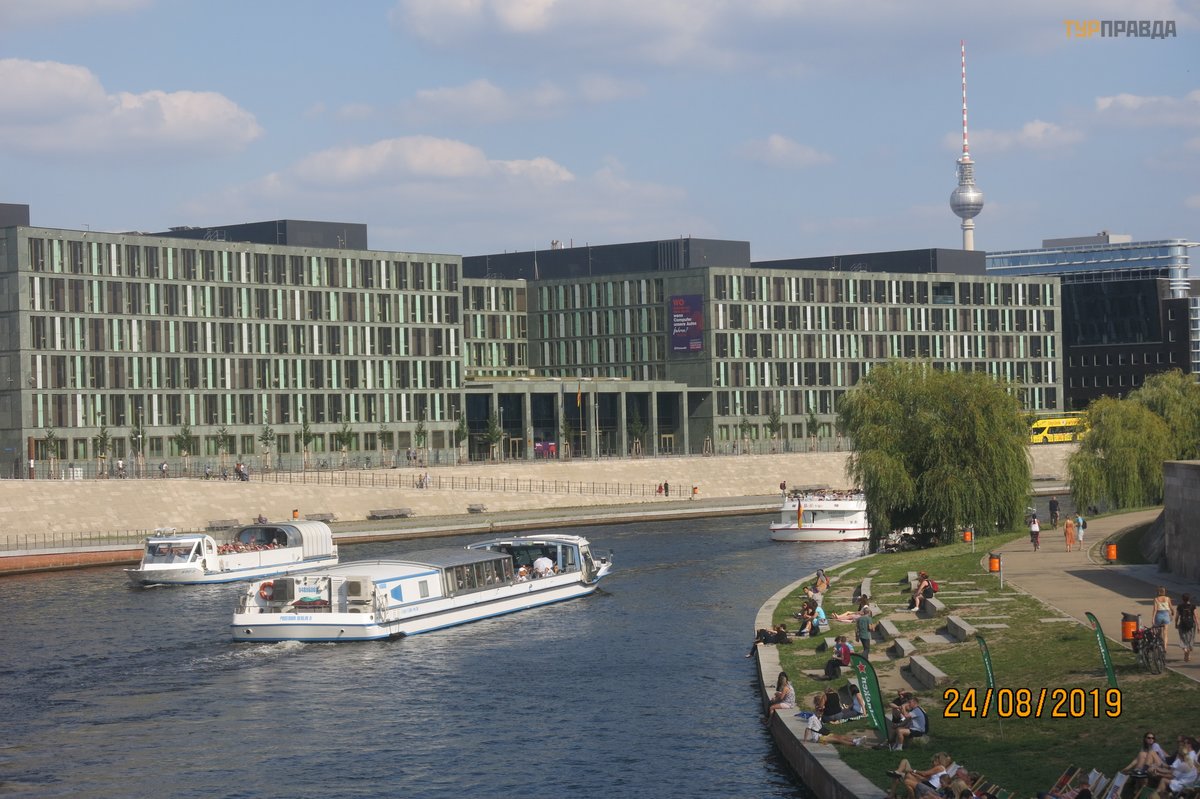
Наступний об’єкт, який хочу відвідати, – площа Потсдамер-Платц. Від Рейстагу можна дістатись на метро, але оскільки прямої лінії немає, з пересадками надто довго, вирішую прогулятись, тим більше це дає можливість побачити ще одне цікаве місце Берліна – величезний парк Тіргартен.Офіційний вхід в парк вже закрито – територія парку по периметру огороджена сітчатим парканом, але бувалому туристу ніщо не завадить пройти через терасу літнього кафе :-). Через Тіргартен проходить проїзна вулиця «17 червня» з пішохідними переходами, а сам парк настільки величезний, що на його території знаходиться Берлінський зоопарк (займаючи при цьому всього лише близько 20% території). В самому парку (деякі взагалі вважають його лісом) розташовано чимало цікавих об’єктів, зокрема Колонна перемоги (із фігурою богині Вікторії, виконаної з золота), Палац Беллью (що є резиденцією Президента Німеччини), Музей культур світу тощо. Але через значні розміри оглянути все це за короткий час, що був у моєму розпоряджені, не було реальним, та я власне і не намагався.
На південь від Тіргартену починається район сучасних будівель (як житлові, так і нежитлові приміщення, в т. ч. навчальні заклади), яким я за 10 хвилин виходжу на Потсдаммер-Платц, район офісних хмарочосів та великий транспортних вузол (пересадочка станція чотирьох ліній S-bahn, двох ліній U-bahn та трьох ліній міжміських електричок RE). Зрозуміло, там знаходяться кілька торгівельних центрів (всі – підземні), в одному з яких (а саме ТЦ «Arkaden») знаходиться відоме європейське мережеве кафе «Nord See», де я власне і вечеряю. Попутно відвідую мережевий магазин ReWe з метою поповнення запасів води на завтрашній насичений день (завтра – неділя, а по неділях німецькі торгівельні мережі мають традицію бути зачиненими).
На вулиці вже майже сьома вечора, час їхати заселитися до готелю, але на шляху до нього хочу заїхати на знамениту торгівельну вулицю Курфюрстендамм. Пройшовши повз черговий фрагмент Берлінської стіни, занурююсь у нетрі берлінських підземок з метою сісти на станцію лінії U3 та їхати у потрібному мені напрямку. Після 20-хвилинного квесту за вказівниками «U3» та кількох підказок місцевих стає зрозумілим, що поїзди вказаної лінії тут просто не зупиняються, а вказівники просто водять людей по колу! Нарешті бачу розумний вказівник, що показує на гору, наступний – на протилежний бік вулиці, до того ж назвою наступної станції потрібного мені напрямку і відстанню до неї в дві сотні метрів. Що ж, пограємо в квест далі. До того ж роздивимось ще один район Берліну, що має всі ознаки нестандартності.
Потрібна мені станція мала назву «Mendelssohn-Bartoldy» і знаходилася на одноіменній вулиці. Називалася, як ви напевне, вже здогадалися, на честь того самого Мендельсона, який написав весільний марш (він, виявляється, був берлінцем), а Бартольді – це прізвище його дружини, після одруження вони взяли собі таке спільне прізвище. Вулиця являла собою бульвароподібний сучасний широкий простр для відпочинку, навіть не бульвар, а цілий парк. Обабіч якого, звісно, розташовувалась кілька смугова проїзна частина. Житлоі будинки з обох боків були сучасні 10-14 поверхові, але без стандартної похмурої потворості. Кожен з будинків мав якусь певну архітектурну деталь: або стіну у вигляді похилої площини, або частину прозорого фасаду над під’їздом тощо. Але що їх об’єднувало, так це наявність вертикальних садів на загальних балконах-терасах.
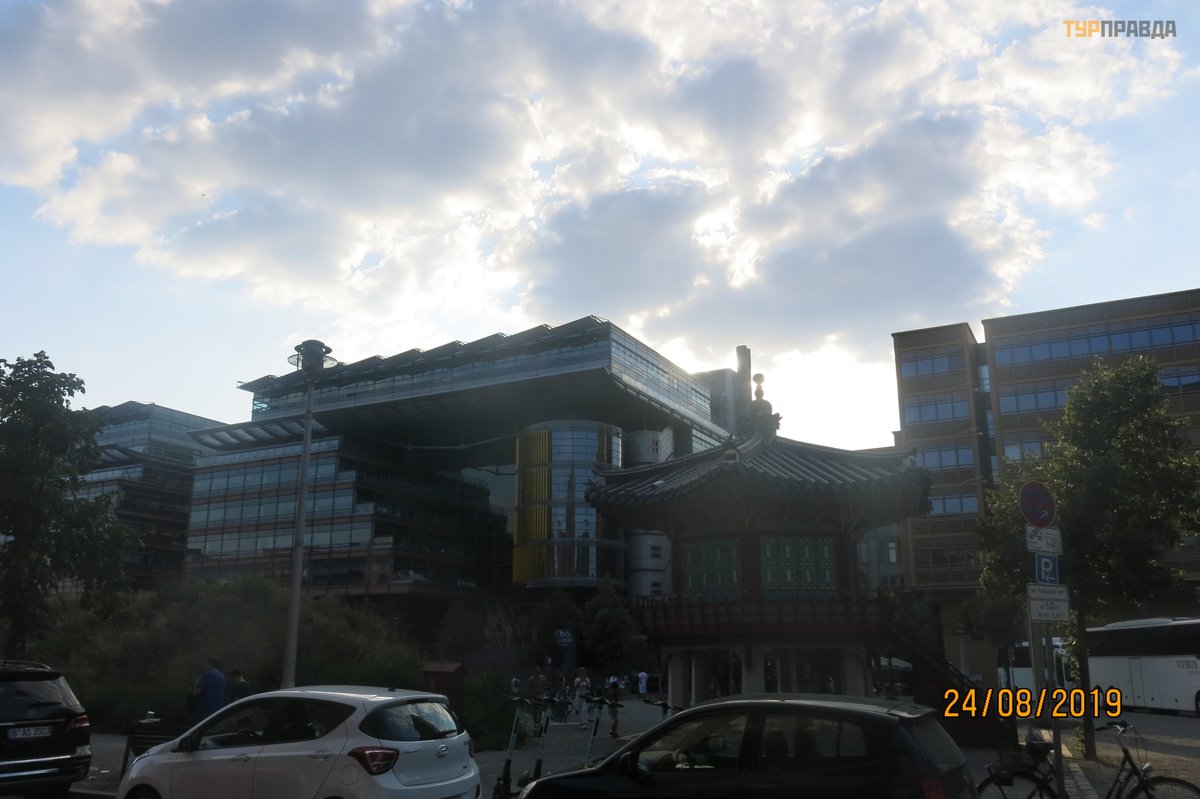
А ось у штучних напівдворах росте декілька великих сосен, просто у кількох метрах від вікон (як вони вціліли під час будівництва – загадка, у нас би в цьом випадку обов’язково б вирубали).
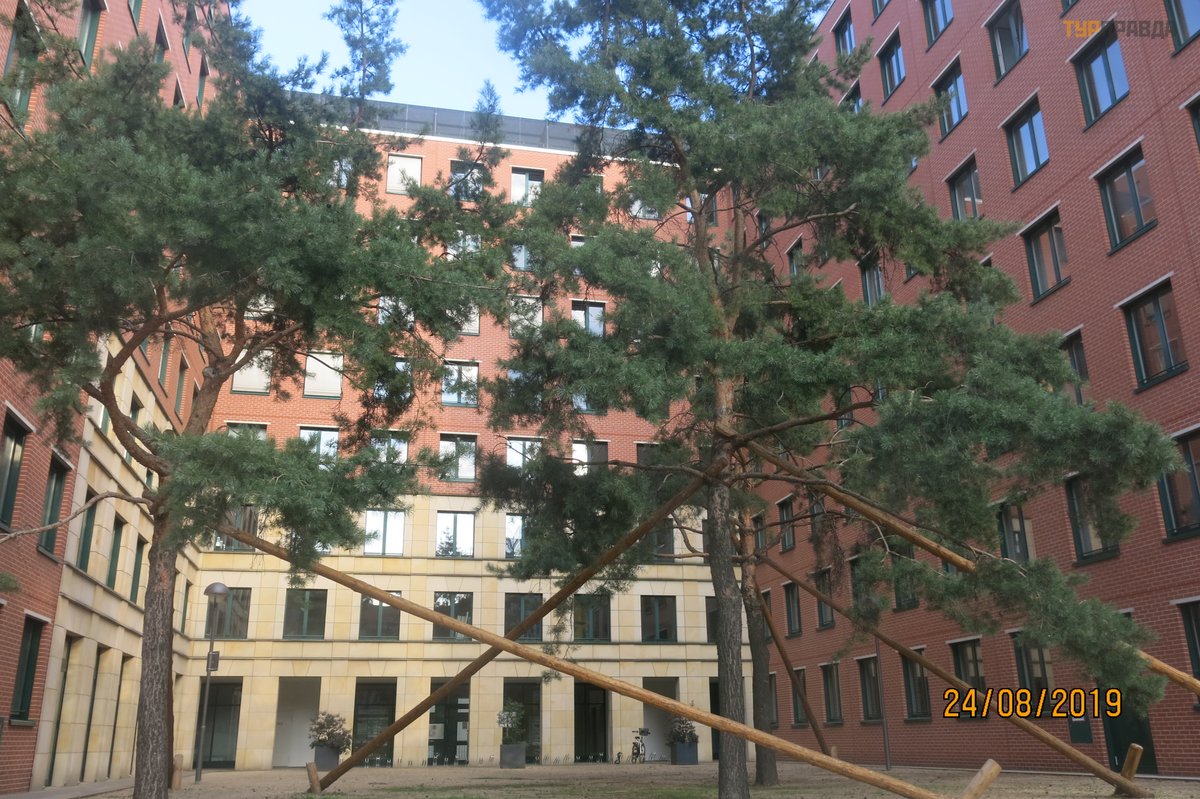
Тим часом непомітно вже підхожу до входу на вказану станцію метро. Вона знаходиться на першому поверсі великого сучасного готелю. (Думаєте, здивувався – аж ніяк, унас також є вхід у метро через перший поверх будинку – «Золоті ворота», «Контрактова площа», «Хрещатик»). Спокійно заходжу через двері у вестибюль, сподіваючись побачити ескалатор або східці, що ведуть вниз. Як би не так! Ескалатор тягнеться нагору, в район другого-третього поверхів! Чесно кажучи трохи розгубився – метро всередині будинку? Але реальність виявилась ще цікавішою – ескалатор провозить мене через будинок наскрізь просто на естакаду.
Метро прокладено за будинками, майже впритул до їхніх стін на висоті 10-15 метрів. Станція сучасна, побудована вочевидь не більше 10-15 років тому (ймовірно ровесниця житлового кварталу, описаного мною трохи раніше), в оздобленні використано багато скла та металу, на підлозі плитка на зразок тієї, якими викладають у торгових центрах. А ось і поїзд – теж цілком сучасний, являє собою суцільну конструкцію, можна переходити між вагонами, але як на мене трохи затісний, хоча пасажирів і не багато. Їхати всього одну зупинку, потім пересадка на станції Gleisdreieck.

Сходи знову ведуть в гору, лінія U2 також проходить по естакаді, але вищій. Станція Gleisdreieck явно старша за віком, всі конструкції на металевих заклепках (тобто побудовані явно в першій третині 20 ст.), вагони також старих модифікацій, до того ж потяги дуже короткі – всього на 4 вагони, але платформа приблизно на третину довша. Підлога платформи вкрита асфальтом. Контраст з лінією U3 дуже різкий.
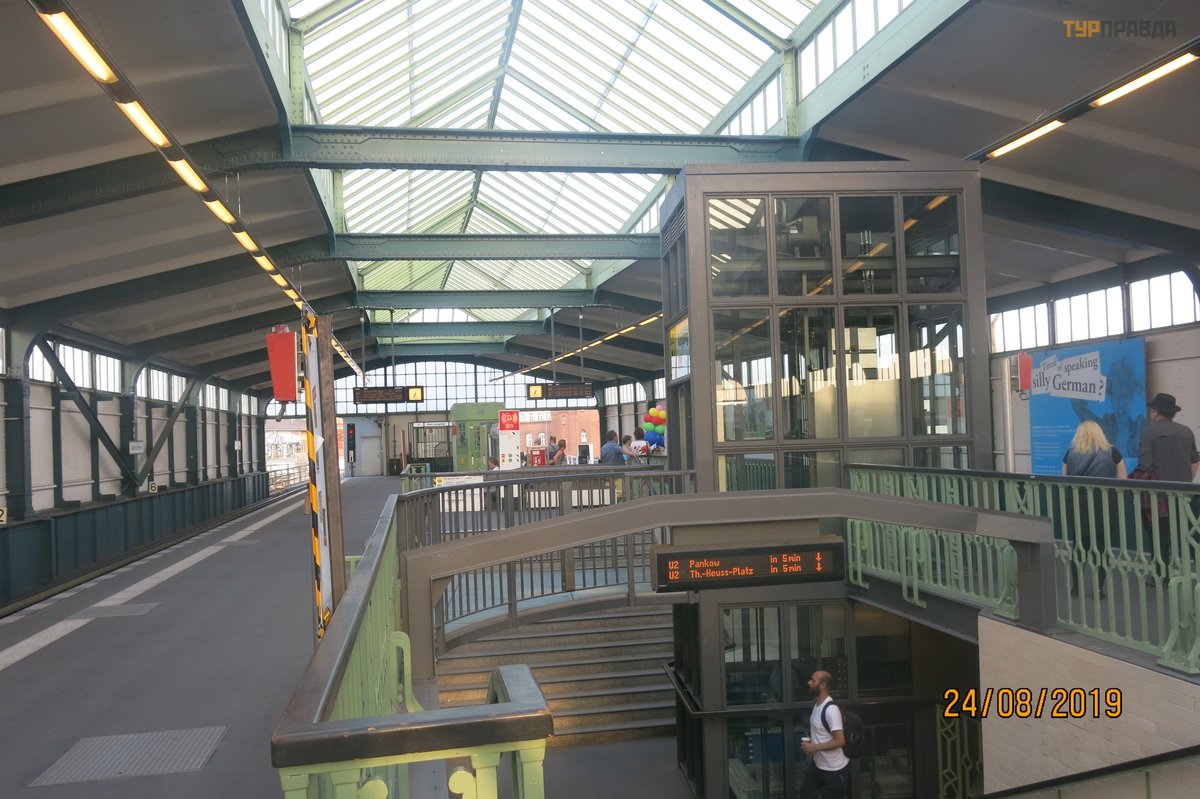
Поки чекаю потяга, розглядає краєвиди навколо. Просто переді мною розташований величезна галявина, названа «Mendelssohn-Bartoldy Park»: клумби із штучним піском (для дітей), лавочки та столи під шатрами (для дорослих), міні-футбольні поля та тенісні корти (для всіх). А навколо 5-6-поверхові житлові квартали невизначеного віку. Ось справжній нетуристичний Берлін!

Прибуває потяг. Їду. Ось тут я зробив помилку у своїй логістиці (напевне, все ж почала даватися взнаки втома): замість станції «Kurfurstendamm» вийшов на «Kurfurstenstrasse». Не повторюйте моєї помилки! Адже ці вулиці не перетинаються, а йдуть майже паралельно, і перейти з однієї на іншу не так вже й просто! Отже, я вийшов на Курфюрстенштрассе. Район звичайний, майже безлюдний, без пам’яток, можна сказати «спальний», крім житлових будинків різного віку (але переважно1950-1960-х рр.) нічого не спостерігається, навіть магазинів. Рухаюсь у визначеному напрямку. Нарешті промайнуло щось на зразок культової споруди, релігію не визначив, але контингент поблизу – в основному люди центрально-американської зовнішності. Кілька разів бачів представниць «найдавнішої професії» , які стояли біля дорогих автомобілів і запрошували перехожих. Напевне, або відвезти на «конспіративні квартири».
Мій шлях пролягає на захід, тобто від центру. Час від часу багатопверхіки з обох боків замінюються ошатними одно- та двоповерховими коттеджами, з рівнем заможності, суб’єктивно, вище середнього. Запам’ятався один 6-поверховий житловий будинок, мешканці якого вочевидь живуть за принципом колективної безпеки – по фасаду з першого до останнього поверху встановлені залізні грати, які унеможливлюють несанкціоноване проникнення на балкони з вулиці. Звичайно, на рівні вікон кожного балкону у гратах є «квартирка», що закривається з середини і дозволяє мешканцям, наприклад, милуватися краєвидами. Всього лиш одна деталь – але дає велику інформацію про безпечність району…

За кількадесят метрів – великий 12-поверховий кілька під’їздний житловий комплекс (не думав, що така житлова багатоповерховість характерна для Західної Німеччини) та кілька великих сучасних готелей. Контрасти на кожному кроці. Нарешті, знаходжу необхідну «січну» вулицю – Ansbacher strasse. Саме на ній я вперше у Берліні побачив «ведмеда» – в 2006 році, напередодні проведення ЧС з футболу у Берліні було встановлено близько 30 3-метрових фігур яскраво розмальованих ведмедів з піднятими догори передніми лапами для привітання гостей міста. Саме тоді зародився мем «Привіт, кросавчеги», нині вже підзабутий.

Ну ось нарешті я на Курфюрстендам – вулиці (точніше, бульварі) універмагів та торгівельних центрів. Одразу на початку бачу один з двох символів вулиці – монументальний 7-поверховий універмаг «KaDeWe». Поряд багато ТЦ поменше, серед вивісок часто зустрічаються китайські бренди, як одяг, так і електроніка. Будинки у переважній більшості сучасні, орієнтовно 1970-х років. Для порівняння: «KaDeWe» (Kaufhaus des Westens – універмаг Заходу) був побудований у 1907 році. У 1943 році магазин було частково зруйновано, але 3 липня 1950 року 180 000 берлінців відсвяткували відновлення його роботи.
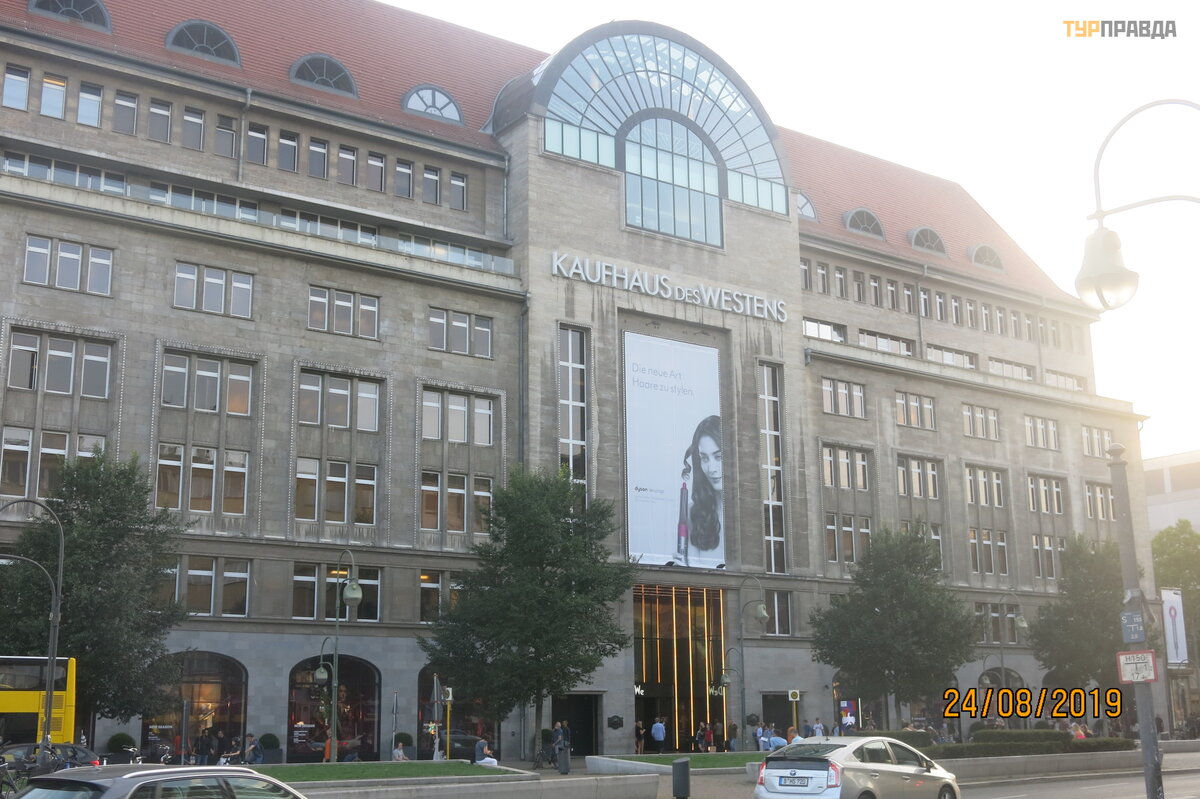
Іншою пам’яткою вулиці є меморіальна церква Кайзера Вільгельма. Під час Другої світової війни церква зазнала сильних руйнувань, фактично від неї залишились тільки частини стін та куполу. Після війни її було вирішено не відбудовувати, а поруч з нею було побудовано сучасну церкву.

Час вже пізній, їду поселятися в готель. На шляху до станції помічаю дуже неординарний фонтан на площі Vittenberg-Platz, з усіх боків оточений скульптурними групами оголених людей. Виглядає досить епатажно, але до парка Вігеллана в Осло йому ще далеко. Що хотів цим сказати автор – невідомо.

Найближча до мене станція все тієї ж лінії U2 – Vittenberg-Platz. Їхати до Kaiser-Platz. Всі станції дуже старовинні і аутентичні, є як підземні, так і наземні. На стінах – мозаїка з плитки, зміст малюнків відповідає тематиці району (зоопарк, федеральний архів, берлінське радіо). Як виявилося, це взагалі найстаріша ділянка метро Берліна (1902-1908 рр. побудови!). Фотографувати, до речі, ніхто не забороняє.

За 15 хвилин виходжу на Kaiser-Platz. Це вже околиця Берліна, поруч кільцева дорога, а за нею приміська курортна зона з озерами. Основні об’єкти: виставковий центр Berlin-Mitte, радіовежа Berlin-Funkturm та центральний автовокзал Berlin-ZOB. Заброньований мною готель має назву «Pension am Funkturm» та займає кілька поєднаних та перебудованих квартир на другому поверсі житлового будинку. Брав по акції, 95 євро за 2 ночі зі сніданком. Не сподобалось: тісно, шумно (ніякої звукоізоляції), посередній сніданок, недружньо настроєний персонал. На сніданок не було ні фруктів, ні овочів (влітку!), ні гарячих страв. Єдина теоретично гаряча справа – варені яйця – подавалася абсолютно холодною. Зате останнього дня, при виселення, я, нікого не знайшовши на рецепції, зайшов у технічне приміщення, де якраз снідав персонал готелю. На столі було повно свіжих овочів. No comments.
Отже, поснідавши, я вирушив на автовокзал (буквально напроти готелю, потрібно просто перейти через міст, 7 хвилин пішки). Сьогодні я вирушаю у місто, про існування якого ми всі чули на уроках шкільної історії, і пам’ятний знак, що засвідчує набуття цієї форми правління, що зародилася в цьому місті, встановлений у Києві.
Ясна річ, всі здогадалися – мова йде про Магдебург. Це невелике німецьке місто увійшло в європейську історію тим, що в ньому першому було створено форму правління, згідно якої голова місцевого самоврядування Vogt (українською «війт») не призначався королем, а обирався місцевою громадою. Мешканці міст звільнили себе від суду феодала й самостійно здійснювали врядування господарством. Для допомоги війту обирали колегіальний орган — магістрат, куди мав право бути обраним кожен з ремісників чи купців, що мав міське право.
З часом Магдебурзьке право з'явилося на території сучасної України разом з німецькими колоністами, яких запрошував король Данило (Галицький) та його наступники. Німці отримали право організовувати в галицьких і волинських містах самоврядні громади (війтівства) з автономними судово-адміністративними інституціями. Після переходу Києва під владу литовських князів Магдебурзьке право було поступово встановлено в Києві. Після знищення запорізького козацтва і приєднання України до Російської імперії Магдебурське право в містах України було відмінено. В Києві остаточно було скасовано у 1835 році російським царем.

А в сучасну історію Магдебург увійшов у 2003 році. За 4 км від міста було побудовано унікальну гідротехнічну споруду – «водний міст». Але про все по порядку.
Виїхав я до Магдебурга автобусом «Flixbus» (вартість квитків 2 боки 14 євро). Автобус привіз мене до автовокзалу Магденбурга, який за традиціями німецьких міст (Берліна це не стосується) знаходиться поруч із залізничним. В Магдебурзі саме влітку проводились масштабні дорожні роботи, тому маршрути громадського транспорту були сильно змінено. Саме тому необхідний мені трамвай №10 ходив по двох розірваних кільцях, а зв’язував їх тимчасовий автобус. Вартість проїзду в один бік складала 1,40 євро. Квитки купив у інформаційному центрі на вокзалі Магдебурга.
Трамвай довіз мене до кінцевої зупинки Barleber See (район великих торгових центрів, в неділю традиційно зачинених). Далі треба йти уздовж траси по тротуару, а біля пісчаного кар’єру повернути праворуч (орієнтир – промислові екскаватори, непомітити неможливо). Звичайно, був інший спосіб дістатись водного мосту – автобус №704 до села Хохенварте, але у вихідні він ходить дуже рідко і його розклад мене не влаштовував. Після повороту йти пішки безпосередньо до каналу. Саме для спрощення і скорочення сполучення між р. Ельбою і Середньонімецьким каналу, що сполучає порти Берліна і порти індустріального Рейнсько-Рурського регіону, і було побудовано це диво інженерної думки.
Справа в тому, що саме в цьому місці спостерігається перепад висот через нерівнинну місцевість, і для його вирівнення вантажні судна (баржі) мали проходити довгий обхідний шлях. Водний міст-акведук разом із шлюзом «Ротензее» значно скорочував маршрут і економив час і кошти. Довжина мосту понад 900 м, з них близько 300 проходить над водою, ширина водної траси 34 метри, глибина 4,25 метрів. Роботи по його будівництву тривали з 1998 по 2003 рік. На його будівництво пішло 24 тисячі тон сталі.



Звичайно, уздовж мосту прокладені пішохідні доріжки, а під мостом є тонелі для пасажирського транспорту. Крім барж мостом курсують прогулянкові теплоходи з Магдебурга (вартість поїздки 14,50 євро). Метрів за 500, не доходячи до мосту, розташовано невеличке селище (із готелем та кафе), де розміщений музей будівництва об’єкту. Від трамвайної зупинки до мосту я йшов близько години (відстань, за відчуттями, близько 3 км), назад – швидше, бо вже точно знав дорогу. Багато місцевих діставались до мосту велосипедами, а біля шлюзу є паркувальний майданчик, на якому того дня було запарковано чимало пересувних фургонів-трейлерів. На іншому боці мосту (зі сторони селища Хохенварте) також є готель з рестораном, а також кілька «куренів» із столиками та лавками для відпочинку. Лавочки для відпочинку є й безпосередньо на самому мосту. Не знаю, може для когось цей об’єкт і не вартий відвідуваня, але мені сподобалося, до того ж їхав в Магдебург не тільки через нього.
Магдебург є дуже своєрідним містом, про це розповідь піде далі. O 16:00 я вже на кінцевій зупинці трамваю 10. Ще кілька хвилин – і я на трамваї та автобусі повертаюсь в центр міста, попутньо його розглядаючи. Що сильно кинулось у вічі – в місті великий університет, його складові (учбові корпуси, кампус, бібліотека) розкидані по всьому місту, всі, крім бібліотеки, сучасні та багатоповерхові.
Магдебург – дуже своєрідне місто Німеччини. В ньому відсутній історичний центр як такий (за винятком Ринкової Площі) у Другу світову війну місто дуже постраждало і його архітектурне обличчя почало формуватися з 1950-х років. Автобус висаджує мене на перетині двох центральних вулиць Отто фон Геріке та Ернста Рейтера.

Вулиця Рейтера – складає враження найбільш ошатної і доглянутої, на ній багато магазинів та невеличкий парк з фонтанами. Будинки -1950-х років, дуже схожі за ситем на будинки побудовані після війни в Києві на Хрещатику, але домінуючі кольори – білий і золотий. І звісно, немає засклених балконів та супутникових антен. По обидва боки перехрестя стоять два 8-поверхові житлові будинки-близнюка такого стилю. Ernest Reuter-Allee переходить в одноіменний міст, яке веде на інший берег річки Ельби. Ліворуч від мосту (набережна відсутня, схили дуже круті) знаходиться невеличкий парк (парки – дуже характерні для Магдебурга, це дуже зелени місто, більшість дерев – липи), в якому розміщена середньовічна Церква Св. Йоганна. А з іншого боку вулиці, через традиційну маленьку площу з традиційним фонтаном і великою статую оленя з золотим ланцюгом на шиї (не знаю, що він означає), знаходиться безпосередньо Історична Ратуша Магдебурга (побудована в 13 ст.). Ліворуч від Ратуші – велика скульптура лицаря Роланда (неодмінний атрибут міста, де діяло Магдебурзьке право) та відносна невелика скульптура «золотого вершника» на високому постаменті у загратованій клітці (хто зна, може й справді з золота).

Біля ратуші знаходиться Ринкова площа, але будинки, що її оточують, сучасні, хоча під старовину. Чому Ратушу називають історичною – тому що зліва від неї за маленькою площею знаходиться діюча міська Ратуша (будинок 19 ст.), в якому засідає мерія міста. Перед діючою Ратушею встановлено пам’ятник найвідомішому уродженцю Магдебурга – фізику Отто фон Геріке (знаменитий тим, що відкрив існування вакууму).

Знову переходжу на протилежну сторону вулиці Рейтера і мимо дуже оригінального і дуже довгого житлового будинку з хвилястим фасадом та мозаїковими панно на торцевих стінах (орієнтовно, 1980-ті роки)

вирушаю в район міста, в якому знаходять його 3 найвідоміші об’єкти, якіі вважаються можна сказати його візитними картками: Монастир Пресвятої Діви Марії (Kloster Unser Lieben Frauen), побудований у 10 ст., зараз в ньому знаходиться міський Музей художнього мистецтва; Магдебурзький Собор Святих Катерини та Маврикія, побудований у 1363 році, вважається найстарішим готичним Собором Німеччини, висота 101 м; Будинок «Зелена Цитадель», побудований у 2000 році знаменитим австрійським архітектором Ф.Хундертвассером.


Тут вже вельми людно, відпочивають як місцеві, так і туристи (в основному, з Південної Азії – орієнтовно Індії або прилеглих країн). На площі працюють модні останнім часом у Європі сухі фонтани. В принципі, дуже зручно, оскільки в місті безліч лип, а літо – саме період їх цвітіння, а тому міський асфальт від них просто липкий. Магдебург не є туристичним містом, не в останню чергу через відсутність аеропорта (хоча за європейськими мірками він не такий і малий – близько 300 тис. мешканців), але наявність у безпосередній близькості великих промислових та культурних центрів Берліна, Дрездена, Лейпціга (що мають на трьох 4 аеропорти, та ще будують п’ятий) зробила аеропорт Магдебурга недоцільним і відсунуло місто далеко вбік від туристичних маршрутів.
Отже, після огляду вказаних об’єктів, прямую до Хауптбанхофу. Для цього мені необхідно перетнути дві паралельні вулиці Брайтервег та вул. Геріке. На обох з них знаних пам’яток не спостерігається, в основному бізнес-центри (як повністю счасні, так і сучасні під старовину), або державні установи. Зрідка – житлові будинки. Єдине, що запам’яталось, – Церква Св. Себастьяна, навколо якого сад із екзотичних дерев. Фото одного з них додається (хто знає, як називається – підкажіть).


Ну ось нарешті на автовокзалі. Мій зворотній рейс FlixBus запізнився аж на 30 хвилин (не дивно, рейс відправлявся аж із Саарбрюккена). З міста виїзжали через район нові житлові масиви (будувалось явно в 1980-х), але виглдають як нові. Не знаю, завдяки чому – чи регулярно підфарбовують чи просто через більш екологічно чисте європейське пальне автомобілів на стінах не утворюється кіптява? На додачу на білих стінах будинках зображене величезні життєстверджуюче граффіті. До побачення, Магдебург!

Шлях пролягав спочатку безкрайніми полями з височеннимм вітрогенераторами, потім дуже довго їхали через ліс вже в сутінках, побачив вказівник на бальнеокурорт Бад-Безінг. Можливо, в наступні приїзду у Східну Німеччину протестую на собі.
Останній день подорожі. Після виселення з готелю прямую на добре знайомий автовокзал. Сьогодні переїзд в Лейпциг, звідки в мене зворотній рейс до Києва. Нажаль, за 2 місяці до подорожі FlixBus відмінив по будніх днях прямий автобус до аеропорту Лейпціга, залишивши лише автобуси до Лейпцігського Хауптбанхофу. Що ж, це здорожчало мою подорож на 5 євро (саме стільки коштує електричка від вокзалу до аерпорту), зате дало 2,5 години часу для поверхневого знайомства з центром Лейпціга.
Перше враження від Лейпцига – це дуже велике місто, тут є багато заможних мешканців та робочих місць, про що свідчать наявність китайських та в’єтнамських розкладок з речами (в Магдебургу такого не було). Весь історичний центр Лейпцига (зберігся досить добре) знаходться просто в межах кільця (Ring). Зважаючи на час, що був у моєму розпорядженні, я вирішив пройти центр наскрізь по Nikolaistrasse, а повернутись на привокзальну площу по Petersstrasse. Ви не повірите, але точкою розвороту мав стати супермаркет LiDL :-). Перші враження – центр міста по-справжньому середньовічний, новобудов мінімум, вулиці вузькі, пішохідні.
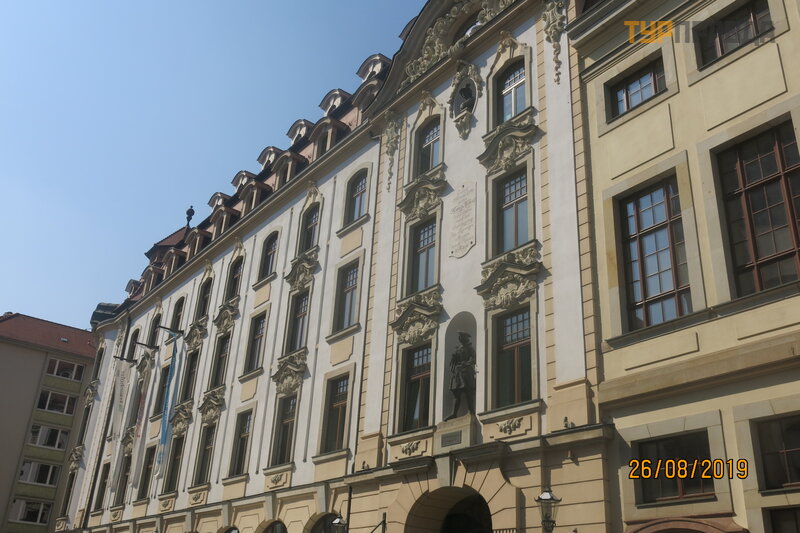

Але явний перебір з торговими точками, як з сувенірними, так і з бутіками. Чомусь забагато магазинів спортивного одягу та інвентарю. Найбільш відомі будівлі по Nikolaistrasse – Церква Св. Миколи, Старовинна Бібліотека Університету та безпосередньо сам Університет. Між іншим у наступному, поряд з Університетом будинку, знаходиться казино (і куди в міністерстві освіти дивляться :-)).

Звісно, йшов не по прямій, а відволікався на різні цікавинки на перпендикулярних вуличках. Однією з них став кафе-магазин чаю, побудований досить давно в індійському стилі. Псля відвідання LiDL, не зважаючи на страшенну спеку, все ж дійшов до Бюргплатц, де побачив надзвичайно старовинний квартал з Новою Ратушою, яку увінчувала величезна башта.

На зворотньому шляху пройшов повз Церкву Св. Фоми, Стару Біржу, та Музей у Старій Ратуші.

Два останні заклади знаходилися на торговій площі, яку продовжував торгівельний Пассаж (також старовинний). Вже на виході з центру розмістились у великі сучасні торгові центри з неодмінними для міст Німеччини Primark та Media Markt. І ось нарешті, знов виходжу на Привокзальну Площу, домінантою якоє є 29-поверхова будівля готелю Marriot.

Залізничні каси вокзалу на ремонті, тому досить легко купую квиток на електричку в автоматі. Електричка в аеропорт відправляється двічі на години, тривалість поїздки 14 хвилин. Мій рейс за розкладом відправляється в 14:45, в аеропорту вже в 13:07. На реєстрація перша несподіванка – рейс переноситься на 15:30. Нічого не підозрюючи, відвідав дьюті-фрі, потім прикордонники "закрили кордон" (поставили штамп у паспорт) і запустили всіх у накопичувач біля гейту. А тут на табло нова інфо – виліт вже о 16:05. З гейту вийти вже не можна, з благ цивілізації тільки WC та торговий автомат з єдиною ціною на все (вода, кока-кола, шоколадки, печиво, горішки – все по 3 євро). Безкоштовної води нам не надав аеропорт (хоча мав би), персонал аеропорту навпаки, при нас автомат ще більш завантажили продуктами… А тут новий час вильоту – 17:25. Цей час вже виявився остаточним, наш літак так приземлився в аеропорту Лейпцига о 17 рівно. В польоті нічого не нагнали і приземлились у Жулянах очікувано 20:40. Ще півтори години дороги – і я вдома. Емоції від східних регіонів Німеччини тільки позитивні.
August 23.2019 at my then job was announced 1 hour shorter. This was very welcome, because a few hours later that evening, the journey began! So, after finishing my work day, I came home, had dinner, packed my backpack, went to the road and went to the airport! As the Wizzair Kyiv-Berlin flight departed at 06:10, and the 92H night trolleybus was not known how and according to the schedule due to the closure of the Shuliavsky Bridge, it was decided to reach the last city trolleybus flights on August 23. The calculation, in principle, turned out to be correct, but the trolleybus №9 finished its work earlier than the appointed hour, ie from Solomianska Square to the airport "Zhulyany" we had to take a walk…
So I got to the airport five minutes before midnight. Many people in the terminal were surprised, although the next flight (Kyiv - Barcelona, Vueling) flew only at 03:55.
Also surprising was the lack of security controls at the entrance to the Zhulyan terminal (as opposed to Boryspil) and the presence of a number of people whose questionable appearance bore little resemblance to travelers. But they sat on (very uncomfortable) seats with low backs next to regular passengers. Check-in for my flight started around 03.30. Considering that 2 and 10 more Wizzair flights departed 5 and 10 minutes after mine, the terminal was very crowded.
Landing on time, the plane is standard, but with a new trend - Wizz in the 2019 season moved to the layout of the cabin with non-reclining seats. I flew four times in 2019 on this airline and all the seats were just that design. Very inconvenient. We sat down at the schedule at 07:20, the border passed quite quickly, although all passengers were forced to present a return ticket or documents from the hotel (electronic boarding and booking were suitable).
Immediately after leaving the arrival hall, I came across a car rental desk, where you could get a free public transport card. And also (for 1 euro) a very detailed map of the city, which included metro stations and city trains (although even such a map once did not help me get lost, but about those later). In Kyiv, bookstores in Berlin did not sell Berlin maps in principle, and online platforms offered a map of the German capital at completely inadequate prices - from UAH 120!
From the terminal on the covered gallery (it is impossible not to notice) I reach the platform of the city electric train (S-bahn). Since I plan to walk around Berlin all day (all one hotel stay no earlier than 3 pm), I decide to buy an unlimited ticket (zones A and B) worth 7.20 E. Sold both at the vending machine and at the box office under the platforms.
On the city train (cute red and yellow cars, very similar in shape to our subway cars, which is no coincidence - after 1945, almost all the surviving cars of the Berlin subway were exported to the USSR, where they were created several generations of subway rolling stock , working on the lines of different cities), despite the early hour of the weekend, there were many passengers.
Initially, the train passed a private low-rise suburban building, which was gradually replaced by high-rise residential areas built in the last years of the GDR (the train entered the city from the east). I got off at the Warschauer Strasse stop in the once industrial, now underground-tourist area of the East-End, near the river Spree. Immediately opposite the train station is the former old building of the famous chemical concern BASF (production of photographic film, video and audio cassettes, diskettes, etc. ).
It is clear why they closed - the production of means of registration and storage of information for the last 10-15 years has reached a qualitatively new level. But on the ground floor of the building (as is traditional in Germany for former industrial buildings) is a chain supermarket LiDL: -). There is also the terminus of the U1 underground line (Warschauer Strasse), which is a few hundred meters away to the beautiful old bridge, which in my opinion is one of the most beautiful buildings in Berlin, built before the XX century. It is called Obermaubryukke, built in 1896, partially destroyed in 1945, and then rebuilt. The bridge has 2 tiers, the lower one is motorized, the upper one is subway. The height of the bridge piers allows the passage of river vessels under it (both pleasure boats and cargo barges).

Approximately 1.5 km from the bridge to the south is in contrast to the historic architectural monument of the XXI century.
- Aluminum installation "Molecular People" by American sculptor Jonathan Borowski, which are silhouettes of three people, located relative to each other at an angle of 60 degrees and pierced by round holes, which should mean that human bodies consist of molecules. The sculptures are mounted directly in the middle of the river on stilts, their height is 30 m, and the total weight is 45 tons.

Right behind the bridge, across the former industrial zone to the north along Mulhemstrasse, will pass another landmark of Berlin, one can even say its symbol of the last 58 years - Berliner Mauer city between the two states. In the East End is its most surviving part, which has been turned into a huge graffiti museum and made a tourist attraction.

There are many tourists, mostly from Central and Southeast Asia, Europeans obviously have these moments in the history of the 20th century. already uninteresting.
From time to time along the wall (and the length of this fragment is about 1.8 km) there are souvenir and antique kiosks and layouts, where next to the standard tourist tinsel (magnets, cups, pens, caps, postcards) can flash old and new symbols of Berlin - red and green men in hats (it was in Berlin at traffic lights that silhouettes of people first appeared, which became symbols of permission and prohibition of movement), as well as a whole layer of antiques from the communist past - military clothing and hats of the second half of the 20th century. and various military paraphernalia. I don't even know who might be interested in it now
Opposite the old, on the other side of the Mulhemstrasse, many modern commercial non-residential real estate (offices, exhibition grounds) has been built, among which the dominant role is played by Mercedes Benz Arena (their analogue of our Sports Palaces).
Yes, I am gradually reaching the Ostbahnhof railway station, which stops not only S-bahn trains, but also long-distance trains, including Kyiv-Berlin (until 2013). Under the station, of course, there is a shopping center. I take the train 1 stop to Alexander-Platz. This is where the city center begins. In the square in the middle of the city is another symbol of Berlin - the Berlin TV Tower. The square is quite crowded, in addition to the subway and train, several tram routes intersect. Alexander Platz is the time of Urania - it displays the time in different time zones.

The next destination of my walk is Museum Island.
On the pedestrian street Ratausstrasse, which is partially blocked by fences due to repairs, I reach the "Red Town Hall" - the current City Hall of Berlin. Built of red brick in 1859-1861. Style - Neo-Renaissance, three-story tower is 75 meters high.
Near the leather corners of the lower tier of the tower are two sculptures of symbols of the city - brown bears. The flag of Berlin is unfurled on the mast of the tower - on a white background with two green stripes at the top and bottom is also, of course, a brown bear. Another interesting fact about the Town Hall: in 1960-1980, West Berliners called the Town Hall red not only because of its own, but also because of the color of those who worked in it - the City Hall of Communist Berlin met in the Town Hall: -)

Of course, there are many cafes and shops along the pedestrian street.
Among them, seeing the well-forgotten "Norma" (I visit Germany quite often, but the stores of this chain are not in every, even big city). The business card of the network - mixtures of fruit and berry jams - are still included in the range, prices - at the level of 2015 - 0.99 euros per 0.25 kg. It is a pity that I was on this trip only with hand luggage.
After passing through a small park overlooking the Marx-Engels-Platz with a monument to relevant historical figures, I come out on the wide Karl-Libknecht-Strasse. At this time there will be a small parade of rare, miniature and very atmospheric cars of the brand "Trabant", which in 1960-1980 was one of the symbols of the GDR. Karl Liebknecht Street will turn into the city of the same name, which leads to the Museum Island. But still on the bridge, looking to the right, my attention was drawn to a very strange structure (see photo below).

Who can learn about this building with a bright dome? Personally, she reminded me of a mosque.
The dominant building of the Island is the Berlin Cathedral (in Germany, all cathedrals in any city are called Dom). The temple impresses with its monumentality and grandeur, although part of its main facade is in scaffolding. The island is extremely crowded, many tourist buses, including
with Ukrainian numbers. There are four existing museums on the Museum Island, namely the Berlin Museum, the Old National Gallery, the Pergamum Museum and the Bode Museum. In front of the Berlin Museum is a large lawn and a beautiful fountain.


Museums were not part of my plans, and there were long queues at the entrance. I leave the Island also on the street. K. Liebknecht across the Palace Bridge, which after Palace Square will lead to the boulevard Unter der Linden.
And on the Palace Square there is a large "antique market", which is actually a "flea market" of speeches of the communist era. To the south of the Palace Square is the Temple with a very unusual green dome - it was the Church of St. Jadwiga.
So, I walk along the boulevard "Under the Lindens" (that's how its name translates), the street is wide and extremely straight, so much so that located in the future Brandenburg Gate (1.5 km long boulevard) can be seen very clearly. Do not walk the subway under the boulevard, it is under construction, but due to certain features of the soil under the boulevard (according to unofficial information, under Unter der Linden was a system of secret tunnels of the Second World War) laying the subway is difficult.
Approximately in the middle of the road is the Bebel Platz, on both sides of which are the buildings of Humboldt University.
The next turn after Bebel Platz is Friedrichstraß e, which leads to the Gendarmerie Square, where there are two very similar, almost identical cathedrals - German and French. And between them is the building of the Concert Hall (former Drama Theater).
A monument to the outstanding German playwright F. Schiller has been erected in front of the building.

The Gendarmenmarkt is a significant tourist destination - along the perimeter of the square and the surrounding streets there are many restaurants, expensive hotels, souvenir shops. Here tourists are offered to ride strange modes of transport: carriages drawn by horse-drawn carriages, an old car with spoke wheels (such a car was also called a "wheelchair" immediately after the invention).

I return to Unter den Linden.
My attention was drawn to the remaining section of the Brandenburg Gate by two other establishments - the Ampelmä nnchen store (the traffic light men I mentioned earlier) and the Digilateria café . The cafe is decorated in the style of Microsoft, and tablets are installed on each table. Here is the Brandenburg Gate.
The last quarters on both sides are almost exclusively embassies of different countries and expensive hotels. A big bike race is being prepared right next to the Gate. Surprisingly, all mature bikers (45-55 years, and even older), no young at all.
Behind the Gates I return to the Reichstag. Of course, I applied on the relevant site for a tour of the construction site or at least for the ascent to the dome, but I was denied: - Well, let's limit ourselves to the external landscape.
In front of the Reichstag building (and, as we know, the German parliament - the Bundestag) - a traditional green lawn and a complex of fountains (which is especially nice in the 35-degree heat that prevailed in those days).

Next, next to the metro station of the same name and a complex of administrative buildings, one of which is completely occupied by the office of the Chancellor (Prime Minister) of Germany Angela Merkel ...

right to the river bank. Spray. There is an artificial recreation area on the waterfront, several hundred folding chairs, many coffee shops, music playing - in short, locals are relaxing. The river in both directions every 5-10 minutes sail large ships with open upper decks, completely filled with passengers. The promenade offers great views of Berlin’s state-of-the-art Central Station and several modern exhibition centers.
 >
>
The next place I want to visit is Potsdamer Platz. From the Reystag you can get to the subway, but since there is no direct line, with transfers for a very long time, I decide to take a walk, especially since it gives the opportunity to see another interesting place in Berlin - the huge Tiergarten Park.
The official entrance to the park is already closed - the territory of the park along the perimeter is fenced with a mesh fence, but the experienced tourist has nothing to stop to pass through the terrace of the summer cafe: -). Tiergarten is crossed by the June 17 carriageway with pedestrian crossings, and the park itself is so huge that the Berlin Zoo is located on its territory (occupying only about 20% of the territory).
Along the way, I will visit the ReWe chain store to replenish water supplies for tomorrow's busy day (tomorrow is Sunday, and on Sundays German retail chains have a tradition of being closed).
It's almost seven o'clock on the street, it's time to check in at the hotel, but on the way there I want to stop at the famous Kurfü rstendamm shopping street. After passing another fragment of the Berlin Wall, I dive into the slums of the Berlin underground to get on the U3 station and go in the direction I want.
After a 20-minute quest on the U3 signs and a few tips from the locals, it becomes clear that the trains of this line simply do not stop here, and the signs just lead people in a circle! Finally I see a clever sign pointing to the mountain, the next - on the opposite side of the street, in addition to the name of the next station I need direction and the distance to it in two hundred meters. Well, let's play the quest next.
In addition, let's look at another area of Berlin, which has all the hallmarks of non-standard.
The station I needed was called "Mendelssohn-Bartoldy" and was located on the street of the same name. It was named, as you may have guessed, after the same Mendelssohn who wrote the wedding march (he turned out to be a Berliner), and Bartholdi is his wife's last name, and after marriage they adopted such a common name. The street was a boulevard-like modern wide space for recreation, not even a boulevard, but a whole park.
On either side of it, of course, was a several-lane carriageway. Dwelling houses on both sides were modern 10-14 storeys, but without the standard gloomy ugliness. Each of the houses had a certain architectural detail: either a wall in the form of an inclined plane, or part of the transparent facade above the entrance, and so on. But what united them was the presence of vertical gardens on common balconies and terraces.
 >
>
But in the artificial courtyards grow a few large pines, just a few meters from the windows (how they survived the construction - a mystery, we would in this case would be sure to cut down).

Meanwhile, I am already imperceptibly approaching the entrance to the specified metro station. It is located on the ground floor of a large modern hotel.
(You think I was surprised - not at all, we also have an entrance near the subway through the first floor of the house - "Golden Gate", "Contract Square", "Khreschatyk"). I calmly walk through the door into the lobby, hoping to see an escalator or stairs leading down. How could it not be! The escalator stretches upwards, to the area of the second or third floors! Honestly, a little confused - the subway inside the house? But the reality turned out to be even more interesting - the escalator takes me through the house straight to the overpass.
The metro is laid behind the houses, almost to their walls at a height of 10-15 meters. The station is modern, built no more than 10-15 years ago (probably the same age as the residential area I described earlier), decorated with a lot of glass and metal, on the floor tiles like those laid out in shopping malls.
And here is the train - also quite modern, is a solid structure, you can switch between cars, but for me a little cramped, although not many passengers. Take only one stop, then change at Gleisdreieck station.

The stairs lead uphill again, the U2 line will also run over the overpass, but higher. The Gleisdreieck station is clearly older, all the structures are made of metal rivets (ie built in the first third of the 20th century), the cars are also old versions, and the trains are very short - only 4 cars, but the platform is about a third longer.
The floor of the platform is covered with asphalt. The contrast with the U3 line is very sharp.

While I'm waiting for the train, I'm looking at the landscapes around me.
Just in front of me is a huge lawn called "Mendelssohn-Bartoldy Park": flower beds with artificial sand (for children), benches and tables under tents (for adults), mini-football fields and tennis courts (for everyone). And around the 5-6-storey residential neighborhoods of indefinite age. Here is a real non-tourist Berlin!

The train arrives. I'm going. Here I made a mistake in my logistics (probably, however, began to show signs of fatigue): instead of the station "Kurfurstendamm" went to "Kurfurstenstrasse". Don't repeat my mistake! After all, these streets do not intersect, but go almost parallel, and to move from one to another is not so easy! So I went out on Kurfü rstenstrasse.
The area is ordinary, almost deserted, without monuments, we can say "sleeping", except for houses of all ages (but mostly1950-1960's. ) Nothing is observed, even shops. I am moving in a certain direction.
Finally, something like a cult building flashed by, without identifying the religion, but the contingent nearby - mostly people of Central American appearance. Several times I saw representatives of the "oldest profession" standing near expensive cars and inviting passers-by. Probably, or take to the "secret apartments".
My path runs west, ie from the center. From time to time high-rise buildings on both sides are replaced by elegant one- and two-storey cottages, with the level of wealth, subjectively, above average.
I remember one 6-storey residential building, the inhabitants of which apparently live on the principle of collective security - on the facade from the first to the last floor there are iron bars, which prevent unauthorized entry to the balconies from the street.
Of course, at the level of the windows of the leather balcony near the lattice there is an "apartment" that closes from the middle and allows residents, for example, to admire the scenery. Just one detail - but it gives a lot of information about the safety of the area…

A few meters away is a large 12-storey multi-entrance residential complex (without thinking that such a multi-storey residential building is typical of West Germany) and several large modern hotels. Contrast at every step. Finally, I find the right "January" street - Ansbacher strasse.
It was here that I saw Berlin for the first time in 2006. It was then that the meme "Hello, sneakers" was born, now forgotten.

Well, finally I'm on the Kurfü rstendamm - the streets (or rather, boulevards) of department stores and shopping malls. Right at the beginning I see one of the two symbols of the street - the monumental 7-storey department store "KaDeWe". There are many smaller shopping malls nearby, and Chinese brands, both clothing and electronics, are often found among the signs. The vast majority of houses are modern, approximately from the 1970s. For comparison: "KaDeWe" ( Kaufhaus des Westens - Western department store) was built in 1907. In 1943, the store was partially destroyed, but on July 3.1950, 18.000 Berliners celebrated the resumption of its work.

Another street attraction is the Kaiser Wilhelm Memorial Church. During the Second World War, the church suffered severe damage, in fact, only parts of the walls and dome remained. After the war, it was decided not to rebuild it, and a modern church was built next to it.

It's late, I'm going to check into the hotel. On the way to the station I notice a very unusual fountain in Vittenberg-Platz, surrounded on all sides by sculptural groups of naked people. It looks rather outrageous, but it is still far from Vigellan Park in Oslo. It is unknown what the author wanted to say.

The nearest U2 station on the same line is Vittenberg-Platz. Drive to Kaiser-Platz. All stations are very old and authentic, there are both underground and terrestrial.
On the walls - a mosaic of tiles, the content of the drawings corresponds to the theme of the district (zoo, federal archives, Berlin radio). As it turned out, this is the oldest section of the Berlin metro (built in 1902-1908! ). By the way, no one forbids taking photos.

I leave for Kaiser-Platz in 15 minutes. This is the outskirts of Berlin, near the ring road, and behind it a suburban resort area with lakes.
Main sites: Berlin-Mitte Exhibition Center, Berlin-Funkturm Radio Tower and Berlin-ZOB Central Bus Station. The hotel I booked is called "Pension am Funkturm" and occupies several combined and rebuilt apartments on the second floor of a residential building. Took on the promotion, 95 euros for 2 nights with breakfast. I did not like: crowded, noisy (no soundproofing), mediocre breakfast, unfriendly staff. There were no fruits, vegetables (summer! ) Or hot dishes for breakfast. The only theoretically hot thing - boiled eggs - was served absolutely cold.
But on the last day, during the eviction, I, not finding anyone at the reception, went to the technical room, where the hotel staff was having lunch. There were a lot of fresh vegetables on the table. No comments.
So, after breakfast, I went to the bus station (literally opposite the hotel, you just need to cross the bridge, 7 minutes walk).
Large-scale road works were carried out in Magdeburg in the summer, so the routes of public transport were greatly changed. That's why the №10 tram I needed ran two broken rings and was connected by a temporary bus. The one-way fare was 1.40 euros. Buying tickets at the information center at Magdeburg Station.
The tram took me to the final stop Barleber See (area of large shopping malls, traditionally closed on Sundays). Then you need to walk along the sidewalk along the route, and turn right near the sand quarry (landmark - industrial excavators, it is impossible not to notice).
Of course, there was another way to get to the water bridge - bus №704 to the village of Hohenwarte, but on weekends it is very rare to go and its schedule did not suit me. After turning, walk directly to the canal. It is to simplify and reduce the connection between p.
The Elbe and the Middle German Canal, which connects the ports of Berlin and the ports of the Rhine-Ruhr region, built this marvel of engineering thought.
The fact is that in this place there is a difference in height due to the rugged terrain, and to level it cargo ships (barges) had to go a long detour. The Aqueduct Water Bridge, together with the Rothensee Gateway, significantly shortened the route and saved an hour and money. The length of the bridge is over 900 m, of which about 300 pass over water, the width of the waterway is 34 meters, the depth is 4.25 meters. Work on its construction lasted from 1998 to 2003. Its construction took 24 thousand tons of steel.
 >
>


Of course, there are footpaths along the bridge, and under the bridge there are tunnels for passenger transport.
In addition to barges, pleasure boats from Magdeburg run on the bridge (the cost of the trip is 14.50 euros). A small village (with a hotel and a cafe) is located 500 meters away, without reaching the bridge, where the museum of construction of the object is located. From the tram stop to the bridge I walked for about an hour (distance, according to sensations, about 3 km), back - faster, because I already know the road. Many locals reached the bridge by bicycle, and there is a parking lot near the gateway, where many mobile vans and trailers were parked that day. On the other side of the bridge (from the village of Hohenwarte) there is also a hotel with a restaurant, as well as several huts with tables and benches for relaxation.
jpg "style =" height: 533px; width: 800px "/>
Reuters Street - gives the impression of the most elegant and well-groomed, it has many shops and a small park with fountains.
Houses from the 1950s, very similar in system to houses built after the war in Kyiv on Khreshchatyk, but the dominant colors are white and gold. And of course, there are no glazed balconies and satellite dishes. On both sides of the intersection will be two 8-storey twin houses of this style. Ernest Reuter-Allee will move to the bridge of the same name, which leads to the other side of the river Elbe. To the left of the bridge (no embankment, very steep slopes) is a small park (parks - very typical of Magdeburg, it is a very green city, most of the trees - linden trees), which houses the medieval Church of St. John.
On the other side of the street, across the traditional small square with a traditional fountain and a large deer statue with a gold chain around its neck (I don't know what it means), is the historic Magdeburg Town Hall (built in the 13th century).
To the left of the Town Hall is a large sculpture of the knight Roland (an essential attribute of the city where Magdeburg law operated) and a relatively small sculpture of the "golden horseman" on a high pedestal in a barred cage (who knows, maybe really gold).

There is a Market Square near the town hall, but the surrounding houses are modern, though old-fashioned. Why the Town Hall is called historic - because to the left of it on a small square is the current City Hall (19th century building), which houses the city hall. A monument to the most famous native of Magdeburg, the physicist Otto von Guericke (famous for discovering the existence of a vacuum), has been erected in front of the current Town Hall.
On both of them there are no known monuments, mostly business centers (both completely modern and modern antiques), or government agencies. Occasionally - residential buildings. The only thing that was remembered - the Church of St.
Sebastian, surrounded by a garden of exotic trees. A photo of one of them is attached (who knows what it's called - tell me).


Well, finally at the bus station. My return FlixBus flight was delayed by as much as 30 minutes (not surprisingly, the flight departed from Saarbrü cken). New housing estates were leaving the city (apparently built in the 1980s), but they look like new ones. I don't know why - whether it is regularly painted or simply because of the cleaner European fuel of cars on the walls does not form soot? In addition, the white walls of the houses depict huge life-affirming graffiti. Goodbye, Magdeburg!

The road passed at first endless fields with high wind turbines, then drove for a long time through the woods at dusk, seeing a sign to the spa resort of Bad Basing.
It is possible that in the next visits to East Germany I will protest to myself.
Last day of travel. After check-out, head straight to the well-known bus station. Today I moved to Leipzig, from where I have a return flight to Kiev. Unfortunately, 2 months before the trip, FlixBus canceled a direct bus to Leipzig Airport on weekdays, leaving only buses to Leipzig's Hauptbahnhof. Well, it made my trip 5 euros more expensive (that's how much the train from the station to the airport costs), but it gave me 2.5 hours for a superficial acquaintance with the center of Leipzig.
First impression of Leipzig is a very large city, there are many wealthy residents and jobs, as evidenced by the presence of Chinese and Vietnamese speech layouts (in Magdeburg, this was not the case). The entire historic center of Leipzig (well preserved) is located just within the ring (Ring).
One of them was a cafe-tea shop, built a long time ago in the Indian style. After visiting LiDL, despite the terrible heat, I still reached Burgplatz, where I saw an extremely old quarter with the New Town Hall, which was crowned by a huge tower.

On the way back he passed the Church of St. Thomas, the Old Exchange, and the Museum near the Old Town Hall.

The last two establishments were located in the shopping area, which was continued by the Trade Passage (also ancient). Already at the exit from the center are located near the large modern shopping centers with essential for the cities of Germany Primark and Media Markt.
And finally, I come out again to the Station Square, which is dominated by the 29-storey building of the Marriot Hotel.

Railway ticket offices are under repair, so it's easy to buy a train ticket in the machine.
The train goes to the airport twice an hour, the duration of the trip is 14 minutes. My scheduled flight departs at 14:45, at the airport at 13:07. The first surprise at check-in is that the flight will be postponed to 15:30. Unsuspecting, after visiting the duty-free, then the border guards "closed the border" (put a stamp in the passport) and launched everyone into the drive near the gate. And here on the scoreboard new info - departure at 16:05. It is no longer possible to leave the gate, only WC and a vending machine with a single price for everything (water, Coca-Cola, chocolates, cookies, nuts - all for 3 euros).
Free water was not provided to us by the airport (although it should), the airport staff on the contrary, we have the machine even more loaded with products… And here the new departure time - 17:25. This hour was already residual, our plane landed at Leipzig airport at 17 exactly. They didn't catch up with the flight and landed in Zhulyany at 20:40. Another hour and a half away - and I'm home.
Emotions from the eastern regions of Germany are only positive.


















































































































